Introduction
Artificial Intelligence (AI) has moved beyond hype, it’s now a business imperative. Companies adopting AI are outpacing competitors by accelerating growth, reducing operational costs, and delivering hyper-personalized experiences. Whether you’re optimizing supply chains, forecasting market demand, or automating customer service, AI is the catalyst for next-level performance. In a fiercely competitive, digital-first economy, leveraging AI isn’t just smart, it’s survival.
What is AI and Why Does It Matter in Business?
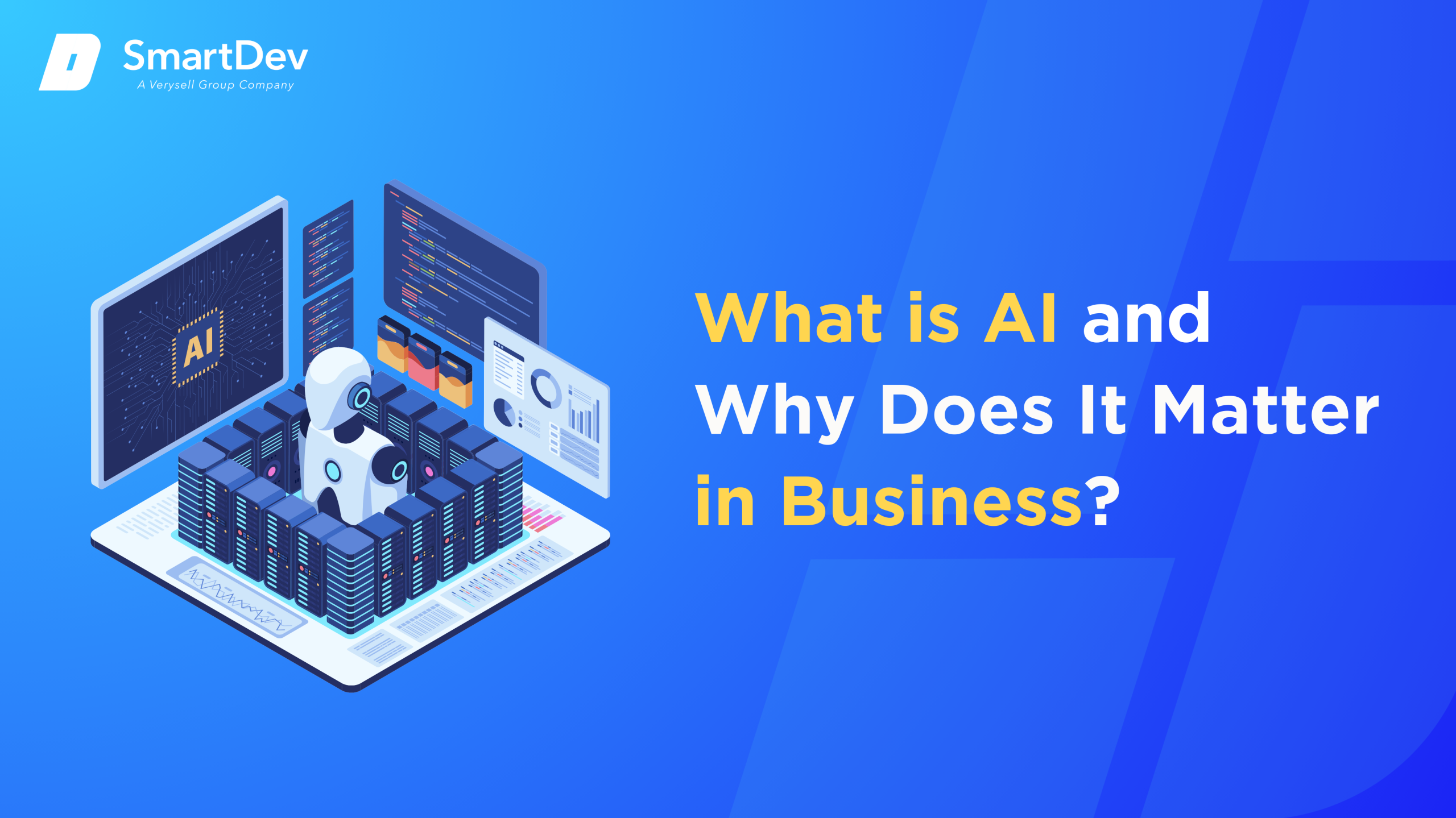
Definition of AI and its core technologies
Artificial Intelligence (AI) refers to the simulation of human intelligence in machines that are programmed to mimic human cognitive abilities, enabling machines to analyze data, recognize patterns, and make informed decisions. At its core, AI encompasses Machine Learning (ML), which allows systems to improve with experience; Natural Language Processing (NLP), which enables computers to understand and generate human language; and Computer Vision, which interprets visual data to enhance automation and analytics.
AI is increasingly critical in business due to its ability to improve decision-making and operational efficiency. It enables organizations to automate repetitive tasks, optimize processes, and deliver faster, data-driven insights. This enhances agility and supports better strategic outcomes.
In today’s digital landscape, adopting AI has become essential rather than optional. Companies using AI solutions gain advantages in customer personalization, cost management, and innovation. As a result, AI is now central to achieving sustainable business growth and resilience.
The Growing Role of AI in Transforming Business
AI adoption in business has expanded rapidly across industries such as finance, retail, healthcare, and manufacturing. These technologies help organizations anticipate trends, streamline operations, and unlock new efficiencies. AI-driven insights support a shift from reactive to proactive decision-making.
Beyond automation, AI enhances human capabilities. By handling routine and data-heavy tasks, AI frees up teams to focus on strategic and creative work. This leads to improved productivity and more innovative approaches to problem-solving.
As AI becomes deeply embedded in daily operations, its role in shaping business success continues to grow. Companies that integrate AI solutions across functions are setting new standards in customer experience, operational excellence, and competitive advantage.
Key Statistics and Trends Highlighting AI Adoption in Business
The global AI market is expanding rapidly, projected to grow from $150 billion in 2023 to over $1.3 trillion by 2030. This surge reflects the increasing demand for AI-driven solutions to enhance productivity and competitiveness across sectors.
AI adoption is rapidly accelerating across industries, with more than 80% of executives considering it essential to achieving strategic goals. As highlighted by McKinsey, sectors like industrial machine learning, cybersecurity, and robotics are experiencing significant adoption growth. AI is increasingly integrated into key business functions such as marketing, finance, HR, and operations, where it improves efficiency, accuracy, and decision-making capabilities.
The benefits are measurable. AI is driving cost reductions, boosting productivity, and opening new revenue opportunities. As more companies realize these advantages, AI continues to emerge as a core enabler of business transformation.
Business Benefits of AI in Business
Artificial Intelligence is fundamentally reshaping how businesses operate, make decisions, and deliver value. As adoption accelerates, it is becoming a core driver of transformation across industries and organizational functions.
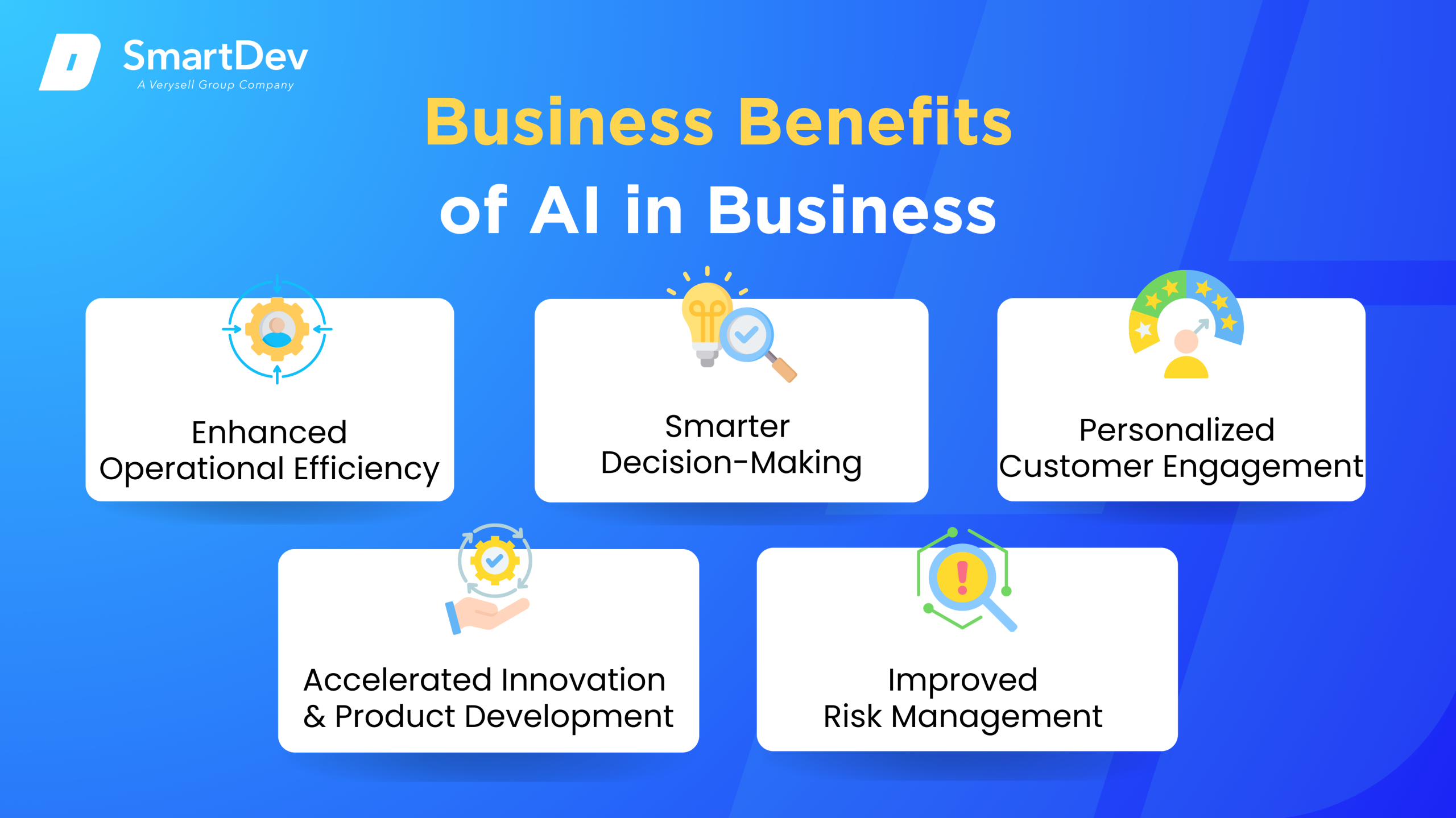
1. Enhanced Operational Efficiency
Across industries, businesses are leveraging AI to streamline operations and reduce inefficiencies. By automating repetitive tasks such as data entry, inventory updates, and customer inquiries, AI frees employees to focus on higher-value activities. This shift not only increases productivity but also minimizes errors and accelerates workflow execution.
Beyond automation, AI introduces predictive capabilities that transform operations from reactive to proactive. Intelligent systems forecast demand, anticipate maintenance needs, and optimize scheduling. As a result, businesses can prevent disruptions, reduce downtime, and achieve substantial cost savings over time.
2. Smarter Decision-Making
In today’s fast-paced environment, data-driven decision-making has become indispensable. AI excels at analyzing complex datasets, identifying patterns, and generating insights that inform strategic choices. Leaders can rely on these outputs to reduce uncertainty and make more confident decisions.
Moreover, AI enhances agility by offering real-time analytics and scenario modeling. Businesses can quickly assess risks, explore alternatives, and respond to market shifts with precision. This ability to adapt swiftly ensures sustained competitiveness in dynamic industries.
3. Personalized Customer Engagement
Creating personalized experiences has become a cornerstone of modern business strategy. AI enables this by analyzing customer behaviors, preferences, and interactions to tailor recommendations, offers, and content. These customized approaches foster deeper connections and elevate overall satisfaction.
The benefits extend far beyond individual transactions. By delivering relevant and timely interactions, businesses can increase conversion rates, strengthen loyalty, and boost customer lifetime value. Personalization powered by AI is no longer optional, it is a key driver of growth and differentiation.
4. Accelerated Innovation and Product Development
Staying ahead in competitive markets requires rapid and continuous innovation. AI supports this need by automating complex processes such as prototyping, testing, and data analysis. This reduces time-to-market and allows teams to iterate and improve products more efficiently.
Additionally, AI enhances creative exploration. Businesses can simulate various scenarios, validate design concepts, and refine offerings with speed and accuracy. By removing barriers to experimentation, AI empowers organizations to launch innovative solutions faster and stay relevant in evolving industries.
5. Improved Risk Management and Compliance
As risks become more complex and regulations more stringent, businesses must adopt smarter approaches to manage them. AI strengthens risk management by continuously monitoring activities, detecting anomalies, and providing early warnings. This proactive stance helps prevent fraud, mitigate operational threats, and safeguard company assets.
Equally important is AI’s role in simplifying compliance. Automated document reviews, real-time regulatory tracking, and standardized reporting reduce manual burdens while ensuring accuracy. Through these capabilities, businesses can maintain compliance with confidence and protect their reputation in an increasingly regulated world.
Challenges Facing AI Adoption in Business
Adopting AI in business offers transformative potential, but the path to integration often presents significant hurdles. From data quality issues to ethical concerns, organizations must navigate several key challenges to fully realize the value AI can deliver.
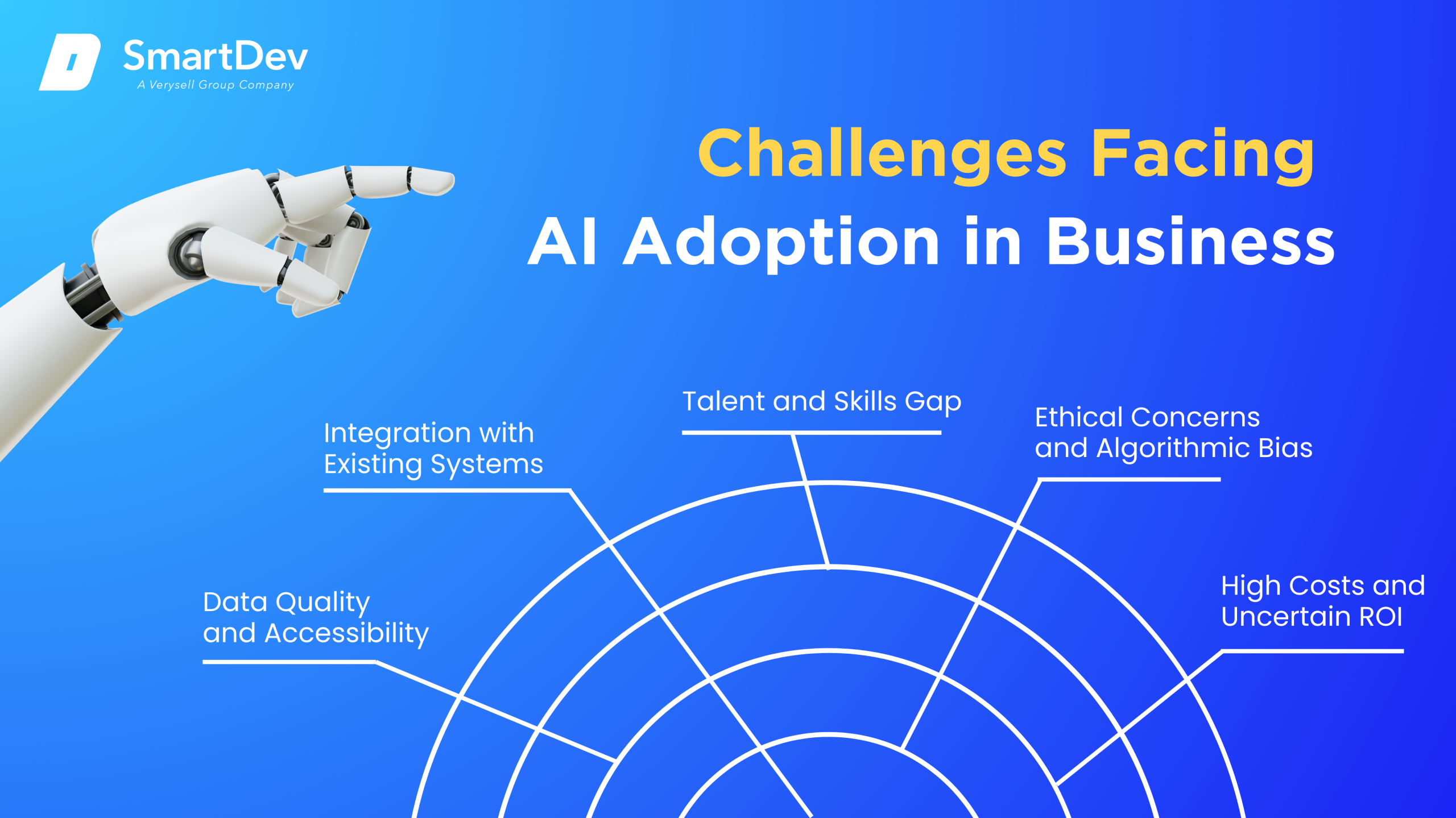
1. Data Quality and Accessibility
AI systems depend heavily on high-quality, structured data to function effectively. Many businesses struggle with fragmented, inconsistent, or incomplete datasets that reduce model accuracy and reliability. Without proper data governance, the risk of drawing misleading insights increases significantly.
Access to relevant data across departments is also a common barrier. Legacy systems, siloed infrastructure, and lack of standardization prevent businesses from fully leveraging their data assets. Overcoming these challenges requires significant investment in data integration and management frameworks.
2. Integration with Existing Systems
Incorporating AI into established business environments often reveals compatibility issues. Many legacy systems were not designed to support modern AI technologies, leading to integration delays and technical limitations. Bridging these gaps requires rethinking architecture and investing in scalable, flexible infrastructure.
Furthermore, aligning AI tools with current workflows can be operationally disruptive. Employees may face learning curves or resist changes in established processes. To succeed, organizations must plan for gradual integration and ensure cross-functional collaboration from the outset.
3. Talent and Skills Gap
Implementing AI solutions requires specialized knowledge that many businesses currently lack. Data scientists, machine learning engineers, and AI strategists are in high demand but short supply. This talent shortage slows down adoption and limits internal innovation capacity.
Even beyond technical roles, there is a growing need for AI-literate managers and domain experts. Upskilling existing teams and fostering a culture of continuous learning is essential to maximize the value of AI investments and ensure successful implementation.
4. Ethical Concerns and Algorithmic Bias
AI can unintentionally reinforce societal or cultural biases present in training data. Without careful oversight, algorithms may produce unfair outcomes in areas like hiring, lending, or customer segmentation. This can lead to reputational damage and regulatory scrutiny.
Ensuring transparency and fairness in AI systems is a growing priority. Organizations must adopt responsible AI practices, such as explainability, bias auditing, and inclusive data sourcing. Addressing these issues early builds trust and ensures long-term viability.
5. High Costs and Uncertain ROI
Deploying AI at scale involves significant upfront investment in technology, talent, and infrastructure. For many businesses, especially small and mid-sized enterprises, these costs can be prohibitive. The financial commitment can feel risky without a guaranteed short-term return.
Additionally, calculating ROI from AI projects is often complex. Results may take time to materialize and are influenced by many variables. Clear success metrics, pilot testing, and phased implementation strategies are crucial for managing expectations and measuring impact effectively.
Specific Applications of AI in Business
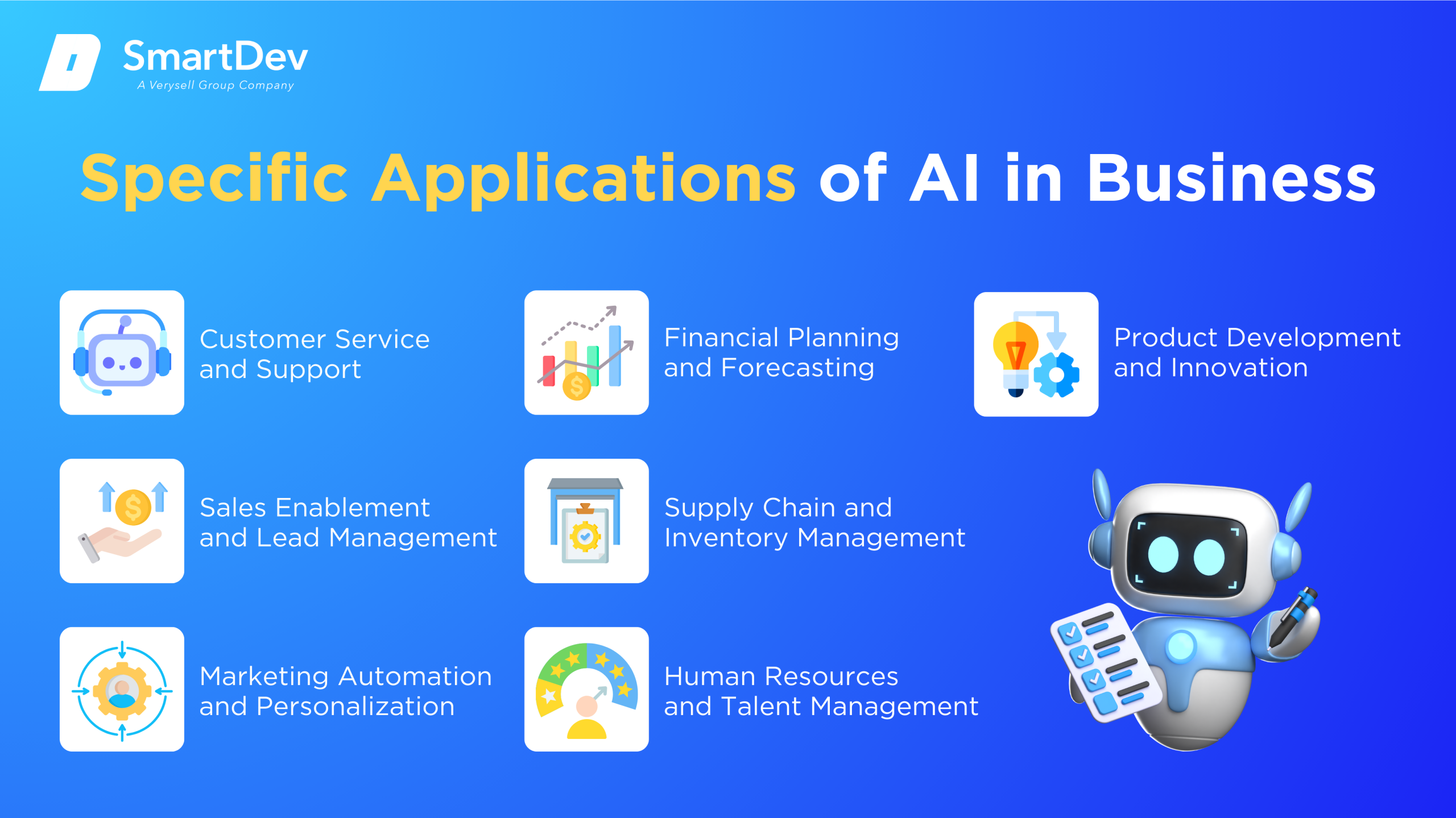
1. Customer Service and Support
AI is reshaping customer service by automating routine tasks and providing real-time, personalized responses. Through AI chatbots and virtual assistants equipped with Natural Language Processing (NLP), businesses can offer instant, 24/7 support, improving service efficiency and reducing human workload.
These systems also analyze past interactions to predict and resolve issues proactively. By continuously learning from customer data, AI tools can offer more relevant solutions, boosting satisfaction and loyalty while optimizing operational costs.
Real-World Case Study: Bank of America
Bank of America uses AI assistant, Erica, to handle millions of customer interactions each month. Erica automates tasks such as transfers and balance checks, leading to improved operational efficiency and customer engagement, while reducing staffing costs.
2. Sales Enablement and Lead Management
AI enhances sales enablement by using predictive analytics to prioritize high-potential leads. By analyzing customer data and past interactions, AI identifies leads most likely to convert, allowing sales teams to focus on prospects with the highest value.
AI also automates repetitive tasks like lead scoring and follow-up scheduling, helping sales teams save time and allocate their efforts more effectively. This streamlined approach results in improved sales performance and faster conversion rates.
Real-World Case Study: Salesforce Einstein
Salesforce Einstein leverages AI to provide sales teams with data-driven insights on lead prioritization. By automating lead scoring and follow-up, businesses can significantly increase sales productivity and conversion rates, optimizing sales pipelines.
3. Marketing Automation and Personalization
Modern marketing relies heavily on personalization, and AI is at the core of making this possible at scale. By analyzing user behavior, preferences, and demographic data, AI segments audiences and delivers relevant content across channels. This improves engagement rates and strengthens brand loyalty.
AI also optimizes campaigns through continuous learning and real-time adjustments. With tools analyzing campaign performance and suggest data-driven refinements to maximize impact, marketers can quickly adapt strategies to changing audience behaviors without manual intervention.
Real-World Case Study: Adobe Sensei
Adobe Sensei automates content creation and personalizes marketing efforts using AI. This tool helps businesses deliver tailored customer experiences, improving engagement and driving higher ROI on marketing campaigns.
4. Financial Planning and Forecasting
AI-driven financial forecasting models analyze vast datasets to predict future revenues, expenses, and cash flow with greater accuracy. By processing historical trends and market conditions, AI helps businesses make more informed decisions about budgeting and resource allocation.
Additionally, AI plays a key role in risk management, identifying financial risks like fraud or market volatility in real time. This allows businesses to act proactively, minimizing potential losses and ensuring financial stability.
Real-World Case Study: KPMG Ignite
KPMG Ignite uses AI to automate financial data analysis, providing businesses with more accurate financial forecasts and risk assessments. This approach has helped clients optimize financial strategies and improve decision-making, reducing risks and enhancing financial performance.
5. Supply Chain and Inventory Management
AI enhances supply chain management by improving demand forecasting and inventory optimization. Through predictive analytics, AI accurately predicts demand trends, ensuring that businesses align stock levels with actual customer needs, reducing both stockouts and waste.
AI also streamlines logistics operations by automating tasks like route optimization and real-time shipment tracking. This boosts operational efficiency, reduces costs, and ensures timely deliveries, which directly impacts customer satisfaction.
Real-World Case Study: Walmart
Walmart uses AI to optimize its inventory management and demand forecasting. In 2023, AI-driven insights helped improve inventory turnover by 10%, reducing waste and ensuring that popular products are always available in stores.
6. Human Resources and Talent Management
AI transforms human resources (HR) by automating tasks such as resume screening and candidate matching, streamlining recruitment efforts. AI algorithms analyze applicant data to identify top talent quickly, reducing hiring time and improving selection accuracy.
Additionally, AI predicts employee turnover and engagement, allowing HR teams to take proactive steps in improving retention. By analyzing employee data, AI provides actionable insights to optimize talent management strategies, enhancing overall workforce productivity.
Real-World Case Study: Unilever
Unilever uses AI through HireVue to automate digital interviews and streamline its recruitment process. This has reduced hiring time and improved candidate selection, enabling Unilever to hire top talent more efficiently and inclusively.
7. Product Development and Innovation
AI accelerates product development by automating testing and prototyping, allowing businesses to bring new products to market faster. By simulating different design scenarios and analyzing market trends, AI helps refine products before committing to large-scale production.
Furthermore, AI drives innovation by offering insights into customer preferences and unmet needs. Analyzing customer feedback and market data enables businesses to create products that better align with consumer demands, fostering innovation and maintaining a competitive edge.
Real-World Case Study: Tesla
Tesla uses AI in its vehicle design and manufacturing processes to optimize performance and safety. Through AI-driven simulations, Tesla can rapidly iterate on designs and enhance product features, ensuring its vehicles remain innovative and competitive in the electric vehicle market.
Examples of AI in Business
Real-World Case Studies

1. Netflix: Personalized Content Recommendation
Netflix utilizes AI to enhance the user experience by offering personalized content recommendations. The AI algorithms analyze data from users’ viewing habits, searches, and ratings to suggest shows and movies tailored to individual preferences. This personalization is central to retaining users and keeping them engaged with the platform.
As a result, 80% of content watched on Netflix comes from AI-driven recommendations. This has played a crucial role in reducing churn, as users are more likely to stay subscribed when content is relevant to them, contributing to Netflix’s strong subscriber growth.
2. Walmart: AI-Driven Inventory and Demand Forecasting
Walmart applies AI to improve inventory management and predict customer demand more accurately. By analyzing historical sales data and external factors like weather, the AI system helps ensure that stores are stocked with the right products at the right time. This prevents both stockouts and overstocking, improving the efficiency of the supply chain.
Through this AI application, Walmart has achieved a 10% improvement in inventory turnover. This reduces operational costs, improves the customer experience by having products available, and ensures better resource allocation within stores.
3. JPMorgan Chase: AI for Legal Document Analysis
JPMorgan Chase uses AI-powered tools like COiN to automate the review and analysis of legal documents. These AI systems scan contracts, identify key clauses, and flag potential issues, tasks that traditionally took legal teams a significant amount of time to complete manually. The tool accelerates the legal review process while reducing human error.
By implementing COiN, JPMorgan has saved 360,000 hours annually, significantly cutting operational costs. This AI solution allows legal teams to focus on more complex, high-value tasks, improving both efficiency and accuracy in their operations.
Innovative AI Solutions
AI in business is advancing beyond simple tasks, becoming a comprehensive solution that transforms entire operations. AI-powered tools now analyze massive datasets in real time, optimizing decision-making across areas like customer service, supply chain management, and marketing.
Generative AI is revolutionizing product development and content creation, enabling businesses to produce personalized materials and designs faster and more cost-effectively. Meanwhile, computer vision is streamlining quality control, enhancing inventory management, and improving diagnostic accuracy in industries like manufacturing and healthcare.
These advancements demonstrate a significant shift: AI is no longer just about automating routine processes, it is emerging as a strategic driver, helping businesses innovate, reduce costs, and elevate performance at every level.
AI-Driven Innovations Transforming Business
AI is unlocking new possibilities for businesses with innovative technologies that drive efficiency and creativity. Generative AI allows companies to automate content creation, product designs, and marketing strategies. By generating personalized content at scale, businesses can save time and resources while delivering tailored experiences that resonate with customers.
Computer Vision is also transforming industries by enabling machines to analyze and interpret visual data. In manufacturing, AI-powered computer vision systems detect defects and ensure product quality, reducing waste and enhancing operational efficiency. Retailers are using this technology for inventory management and to optimize the in-store experience, improving both logistics and customer satisfaction.
How to Implement AI in Business
To successfully implement AI, business leaders must develop a clear vision for its integration, focusing on areas such as automation, decision-making, or innovation. Key considerations, including data availability, ethical implications, and cybersecurity risks, should guide the selection of the most suitable AI solutions for the business.
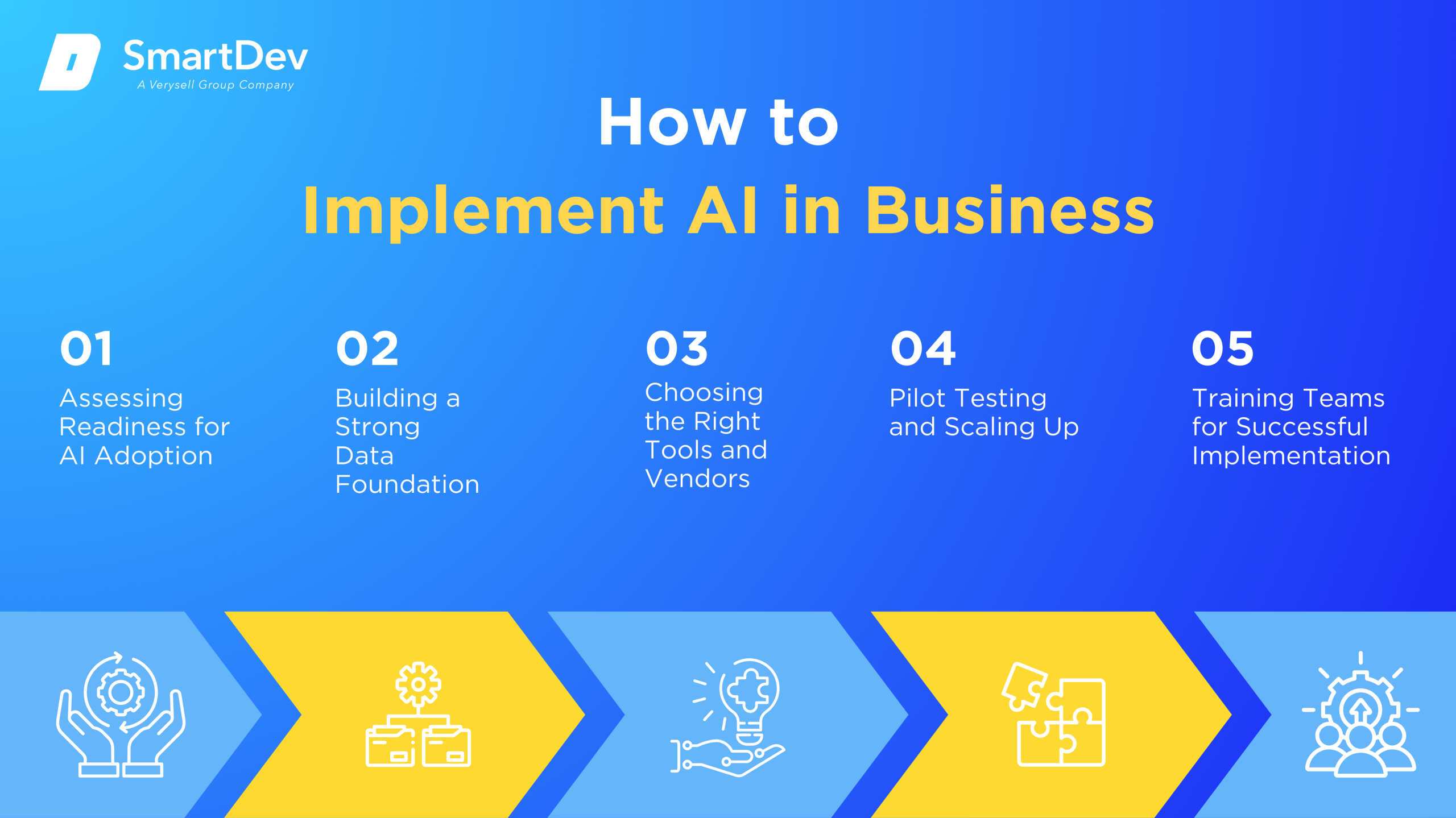
Step 1. Assessing Readiness for AI Adoption
Before integrating AI into your business, it’s important to assess which areas will benefit most from AI solutions, such as automating tasks or improving decision-making.
You should also evaluate your current infrastructure to ensure your business is prepared for a smooth and successful AI implementation.
Step 2. Building a Strong Data Foundation
For AI to work effectively, your business needs a strong data foundation.
This means collecting, cleaning, and managing your data to ensure it is accurate, reliable, and compliant with regulations so that your AI systems have the best possible input to make informed decisions.
Step 3. Choosing the Right Tools and Vendors
Selecting the right AI tools and platforms is crucial for your business.
Make sure to evaluate vendors based on how well their solutions fit your needs, how scalable they are, and their ability to integrate with your existing systems to ensure a successful long-term partnership.
Step 4. Pilot Testing and Scaling Up
Start with small-scale pilot projects to test AI solutions in real-world situations.
Once the pilot is successful, you can scale the implementation across your business, ensuring that AI solutions deliver value and align with your business goals.
Step 5. Training Teams for Successful Implementation
To maximize the potential of AI, it’s important that your team understands how to work with AI systems.
Offering training and fostering a culture of continuous learning ensures that your employees are equipped to use AI effectively, helping your business get the most value from the technology.
Measuring the ROI of AI in Business
Measuring the ROI of AI is essential for understanding its impact on business performance. By tracking key metrics such as cost savings and productivity improvements, businesses can assess the value AI brings to their operations and make data-driven decisions for future investments.
Key Metrics to Track Success
- Cost Reduction: AI lowers operational costs by automating manual tasks. Tracking savings in labor and resource allocation highlights its financial impact.
- Productivity Improvements: Automating repetitive tasks boosts productivity. Measuring time saved and increased output shows how AI allows teams to focus on strategic work.
- Customer Satisfaction and Engagement: AI personalizes customer experiences, improving satisfaction and loyalty. Monitoring engagement rates and retention reveals AI’s impact on long-term growth.
- Operational Efficiency: AI streamlines operations and reduces bottlenecks. Measuring cycle times and task completion rates demonstrates its role in enhancing efficiency.
Case Studies Demonstrating ROI
Leading businesses are seeing impressive returns from incorporating AI into their operations. Amazon uses AI in its fulfillment centers to optimize inventory management and streamline delivery routes, which has improved order processing times and cut costs.
Meanwhile, Coca-Cola applies AI-driven demand forecasting to better align production with customer needs, reducing waste and improving supply chain efficiency. This approach has resulted in significant cost savings and enhanced inventory control.
These real-world examples show how AI can not only reduce costs but also drive long-term business growth by improving efficiency, customer satisfaction, and overall operational performance.
Common Pitfalls and How to Avoid Them
- Poor Data Quality: Inaccurate or incomplete data can lead to unreliable AI insights. Ensure data is clean, consistent, and well-structured before feeding it into AI models to avoid skewed results.
- Misaligned Objectives: AI initiatives may fail if they aren’t aligned with business goals. Clearly define the objectives of AI projects to ensure they contribute to your overall strategy and success metrics.
- Underestimating Integration Complexity: Integrating AI into existing systems can be challenging. Plan for a gradual rollout, starting with pilot projects, to address integration issues before full-scale implementation.
- Overlooking Employee Training: Lack of training can hinder AI adoption. Invest in upskilling employees and fostering an AI-driven culture to ensure smooth collaboration between technology and teams.
- Unrealistic Expectations: AI results may take time to materialize, and expecting immediate returns can lead to disappointment. Set realistic timelines, manage expectations, and allow for iterative improvements.
Future Trends of AI in Business
Predictions for the Next Decade
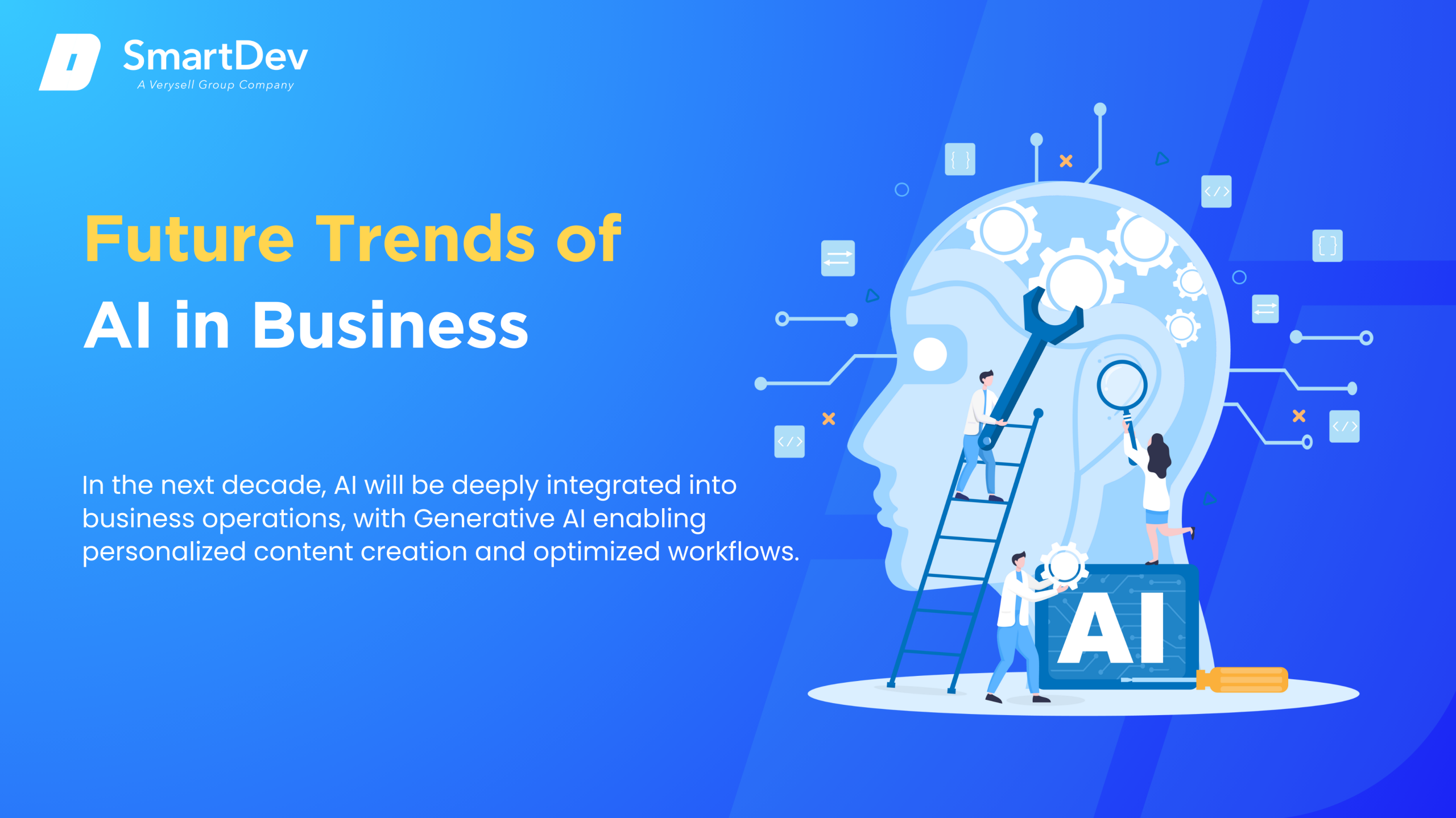
In the next decade, AI will be deeply integrated into business operations, with Generative AI enabling personalized content creation and optimized workflows. This will improve efficiency and customer engagement, allowing businesses to scale tailored experiences across departments.
AI will evolve from a reactive tool to a proactive decision-maker, predicting market trends and customer needs. As AI drives automation across industries, businesses will reduce costs, optimize operations, and free up resources for innovation, ensuring they stay ahead in a competitive market.
How Businesses Can Stay Ahead of the Curve
To stay ahead, businesses must continuously embrace the latest AI advancements like AI-powered automation and edge computing. Regularly updating AI systems ensures companies remain agile, adapting quickly to market changes and maintaining a competitive advantage.
Building a culture of AI literacy is equally important, as training employees to effectively use AI tools helps integrate these systems into daily operations. Additionally, forming strategic partnerships with AI researchers and technology providers accelerates innovation, keeping businesses at the forefront of technological progress.
Conclusion
Key Takeaways
AI is transforming business operations, offering powerful tools to enhance efficiency, improve customer experiences, and drive innovation. By understanding key use cases and leveraging AI’s potential, businesses can unlock significant value across various departments.
- Enhanced Decision-Making Through Data: AI enables businesses to analyze vast amounts of data, providing actionable insights for smarter decision-making. By leveraging machine learning algorithms, companies can predict trends, optimize processes, and stay ahead of competitors, making data-driven decisions in real time.
- Fraud Detection and Risk Mitigation: Real-time monitoring of transactions and network activities helps identify anomalies and prevent fraudulent actions. These intelligent systems detect suspicious patterns, minimizing financial losses and bolstering security, particularly in industries prone to high-risk activity.
- Personalized Customer Engagement: Through advanced recommendation systems and virtual assistants, businesses can deliver highly tailored experiences. By understanding customer behavior and preferences, businesses foster stronger relationships, increase satisfaction, and improve customer retention.
- Operational Efficiency and Automation: AI-powered automation tools streamline business operations, reducing manual effort and operational costs. From automating routine tasks to optimizing supply chains, AI increases efficiency, boosts productivity, and allows employees to focus on more strategic initiatives.
- Strategic Innovation and Competitive Advantage: The ability to uncover new insights and improve existing products gives businesses the agility to stay ahead of competitors. With AI uncovering new opportunities, businesses can drive strategic innovation and remain adaptable in a rapidly evolving market.
Moving Forward: A Path to Progress
AI is revolutionizing business across every sector, from customer service automation and predictive analytics to personalized marketing and operational efficiency. To stay competitive, businesses must embrace AI innovation, refine their data strategies, and empower teams to leverage AI as a core driver of business growth.
By integrating AI into every aspect of business operations, companies can unlock new levels of efficiency, enhance customer experiences, and foster innovation. Those who take proactive steps to adopt AI today will lead the way in transforming their industries, offering smarter, more agile, and customer-focused solutions.
At SmartDev, we help businesses harness AI’s full potential. From AI-powered automation and data analytics to customer engagement solutions, our team delivers customized, industry-specific technologies that drive tangible, measurable outcomes.
Contact us today to learn how our AI solutions can help optimize your operations, increase efficiency, and enhance customer experiences, all while giving you a competitive edge in an AI-driven world.
—
References:
- Real-World Uses Of AI In Business: What You Need To Know Today | Forbes
- The Most Valuable AI Use Cases for Business | IBM
- Artificial Intelligence: How Leading Companies Define Use Cases, Scale-up Utilization, and Realize Value | Springer Link
- The economic potential of generative AI | McKinsey & Company
- 10 ways JP Morgan is using AI – Case Study [2025] | Digital Defynd
- How Top 25 Largest Retail Companies Use AI | Redress Compliance







